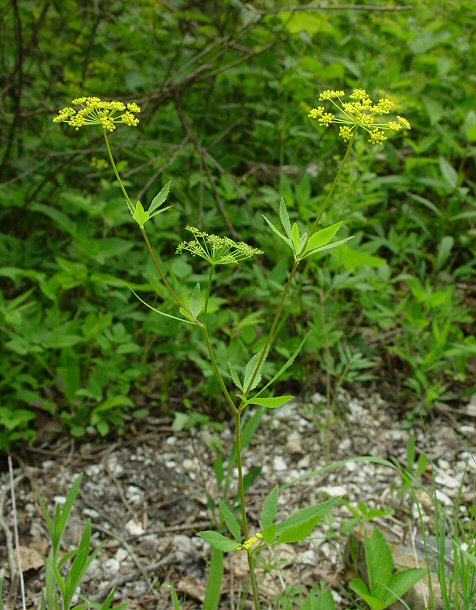Zizia aurea (L.) W.D.J. Koch
Common Golden Alexanders

Native
CC = 5
CW = 0
MOC = 71
© DETenaglia
Zizia aurea (L.) W.D.J. KochCommon Golden Alexanders | |
 |
Native CC = 5 CW = 0 MOC = 71 |
© DETenaglia |
|
Family - Apiaceae Habit - Perennial forb with clusters of slightly to moderately tuberous-thickened roots. Stems - Ascending to erect, to 1.1 m, glabrous or nearly so, sometimes branching.
Leaves - Alternate and usually basal, the lower leaves long-petiolate, the upper stem leaves short-petiolate to nearly sessile, the sheathing bases only slightly inflated. Basal leaves with the blades 4-14 cm long, 1 or 2 times ternately compound, the leaflets 1-12 cm long, broadly ovate to oblong-obovate or lanceolate, narrowed to rounded (often unequally) or cordate at the base, sometimes with 1 or 2 lobes toward the base. Stem leaves similar to the basal leaves, gradually reduced toward the stem tip, becoming more finely divided with somewhat narrower leaflets and/or segments, the uppermost often only ternately 1-3 times deeply lobed.
Inflorescence - Terminal compound umbels with 10-21 main rays, these to 5.0 cm long, glabrous. Involucre absent. Rays of umbellets to 4 mm long, glabrous. Involucel of 3-9 bractlets, these shorter than the flower stalks, linear, sometimes reduced and fused basally into a low, irregular crown. Flowers 11-19 in each umbellet, the central floret of each umbellet sessile or with a stalk less than 0.5 mm long, the others with stalks 1-4 mm long.
Flowers - Sepals minute triangular scales. Petals 5, obovate, narrowed or tapered abruptly to a short, slender tip, bright yellow. Stamens 5, alternating with petals, spreading to erect, exserted. Filaments pale yellow, 1.8 mm long. Anthers yellow, 0.3 mm long. Ovaries glabrous.
Fruits - Schizocarps 2-4 mm long, ovate to oblong-ovate in outline, flattened laterally, glabrous, the mericarps reddish brown, the 5 ribs tan to yellowish brown, angled and often somewhat corky, but lacking wings.
Flowering - April - June. Habitat - Bottomland and mesic forests, prairies, glades, savannas, streambanks, bluffs, fields, roadsides. Origin - Native to the U.S. Lookalikes - Thaspium trifoliatum; also Zizia aptera. Other info. - The species name aurea means "golden" and the flowers are certainly that. This attractive plant is found across Missouri, less commonly in the Bootheel and the northwestern portion of the state. Beyond Missouri its range includes most of the eastern half of the continental U.S. Photographs taken at the Kansas City Zoo, 5-2-00, and in Eminence, MO., 5-23-03 (DETenaglia); also at Washington State Park, Washington County, MO, 5-03-2014; Shaw Nature Reserve, Franklin County, MO, 6-20-2014 and 5-17-2023; St. Joe State Park, St. Francois County, MO, 5-13-2015; Washington State Park, Washington County, MO, 7-14-2017; and Shut-in Mountain fen, Shannon County, MO, 5-19-2023(SRTurner). |